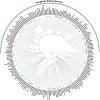Extra-pair paternity in birds
- PMID: 31587397
- PMCID: PMC6899757
- DOI: 10.1111/mec.15259
Extra-pair paternity in birds
Abstract
Since the first molecular study providing evidence for mating outside the pair bond in birds over 30 years ago, >500 studies have reported rates of extra-pair paternity (EPP) in >300 bird species. Here, we give a detailed overview of the current literature reporting EPP in birds and highlight the sampling biases and patterns in the data set with respect to taxonomy, avian phylogeny and global regions, knowledge of which will be crucial for correct interpretation of results in future comparative studies. Subsequently, we use this comprehensive dataset to simultaneously test the role of several ecological and life history variables. We do not find clear evidence that variation in EPP across socially monogamous species can be explained by latitude, density (coloniality), migration, generation length, genetic structuring (dispersal distance), or climatic variability, after accounting for phylogeny. These results contrast previous studies, most likely due to the large heterogeneity within species in both EPP and the predictor of interest, indicating that using species averages might be unreliable. Despite the absence of broadscale ecological drivers in explaining interspecific variation in EPP, we suggest that certain behaviours and ecological variables might facilitate or constrain EPP, as indicated by our finding that EPP was negatively associated with latitude within noncolonial species, suggesting a role of breeding synchrony. Thus, rather than focussing on general explanations for variation in EPP across all species, a future focus should be on how various aspects of ecology or life history might have driven variation in EPP among groups of species or populations of the same species. Hence, we argue that variation in EPP can be partly explained when taking the right perspective. This comprehensive overview, and particularly the dataset provided herein will create a foundation for further studies.
Keywords: mating system; microsatellites; parentage; polyandry.
© 2019 The Authors. Molecular Ecology published by John Wiley & Sons Ltd.
Figures










References
-
- Akçay, E. , & Roughgarden, J. (2007). Extra‐pair paternity in birds: Review of the genetic benefits. Evolutionary Ecology Research, 9, 855–868.
-
- Arct, A. , Drobniak, S. M. , & Cichoń, M. (2015). Genetic similarity between mates predicts extrapair paternity – A meta‐analysis of bird studies. Behavioral Ecology, 26(4), 959–968. 10.1093/beheco/arv004 - DOI
-
- Biagolini, C. , Westneat, D. F. , & Francisco, M. R. (2017). Does habitat structural complexity influence the frequency of extra‐pair paternity in birds? Behavioral Ecology and Sociobiology, 71(7), 101 10.1007/s00265-017-2329-x - DOI
-
- Birkhead, T. R. , & Biggins, J. D. (1987). Reproductive synchrony and extra‐pair copulations in birds. Ethology, 74, 320–334.
Publication types
MeSH terms
LinkOut - more resources
Full Text Sources

